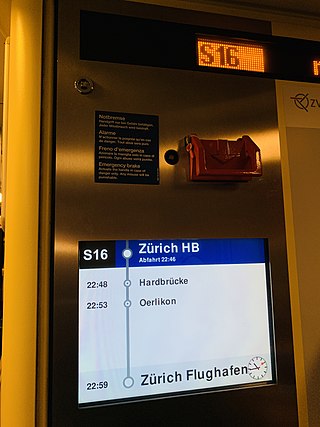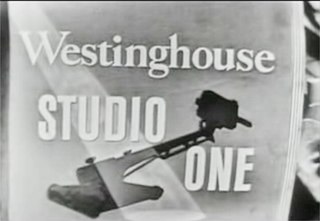Related Research Articles
The RCA Corporation was a major American electronics company, which was founded as the Radio Corporation of America in 1919. It was initially a patent trust owned by General Electric (GE), Westinghouse, AT&T Corporation and United Fruit Company. In 1932, RCA became an independent company after the partners were required to divest their ownership as part of the settlement of a government antitrust suit.

I Love Lucy is an American television sitcom that originally aired on CBS from October 15, 1951, to May 6, 1957, with a total of 180 half-hour episodes, spanning six seasons. The show starred Lucille Ball, her husband, Desi Arnaz, along with Vivian Vance and William Frawley. The series followed the life of Lucy Ricardo (Ball), a young, middle-class housewife living in New York City, who often concocted plans with her best friends and landlords, Ethel and Fred Mertz, to appear alongside her bandleader husband, Ricky Ricardo (Arnaz), in his nightclub. Lucy is depicted trying numerous schemes to mingle with and be a part of show business. After the series ended in 1957, a modified version of the show continued for three more seasons, with 13 one-hour specials, which ran from 1957 to 1960. It was first known as The Lucille Ball–Desi Arnaz Show, and later, in reruns, as The Lucy–Desi Comedy Hour.

Color television or colour television is a television transmission technology that includes color information for the picture, so the video image can be displayed in color on the television set. It improves on the monochrome or black-and-white television technology, which displays the image in shades of gray (grayscale). Television broadcasting stations and networks in most parts of the world upgraded from black-and-white to color transmission between the 1960s and the 1980s. The invention of color television standards was an important part of the history and technology of television.
The year 1956 in television involved some significant events. Below is a list of television-related events during 1956.
The year 1954 in television involved some significant events. Below is a list of television-related events in 1954.

A flat-panel display (FPD) is an electronic display used to display visual content such as text or images. It is present in consumer, medical, transportation, and industrial equipment.

A television set or television receiver, more commonly called the television, TV, TV set, telly, tele, or tube, is a device that combines a tuner, display, and loudspeakers, for the purpose of viewing and hearing television broadcasts, or as a computer monitor. Introduced in the late 1920s in mechanical form, television sets became a popular consumer product after World War II in electronic form, using cathode ray tube (CRT) technology. The addition of color to broadcast television after 1953 further increased the popularity of television sets in the 1960s, and an outdoor antenna became a common feature of suburban homes. The ubiquitous television set became the display device for the first recorded media for consumer use in the 1970s, such as Betamax, VHS; these were later succeeded by DVD. It has been used as a display device since the first generation of home computers and dedicated video game consoles in the 1980s. By the early 2010s, flat-panel television incorporating liquid-crystal display (LCD) technology, especially LED-backlit LCD technology, largely replaced CRT and other display technologies. Modern flat panel TVs are typically capable of high-definition display and can also play content from a USB device. Starting in the late 2010s, most flat panel TVs began to offer 4K and 8K resolutions.

KDKA-TV is a television station in Pittsburgh, Pennsylvania, United States, airing programming from the CBS network. It is owned and operated by the network's CBS News and Stations division alongside Jeannette-licensed CW affiliate WPCW. Both stations share studios at the Gateway Center in downtown Pittsburgh, while KDKA-TV's transmitter is located in the city's Perry North neighborhood. KDKA-TV, along with sister station KYW-TV in Philadelphia, are the only CBS-affiliated stations east of the Mississippi River with "K" call signs.

The Westinghouse Broadcasting Company, also known as Group W, was the broadcasting division of Westinghouse Electric Corporation. It owned several radio and television stations across the United States and distributed television shows for syndication.

WKYC is a television station in Cleveland, Ohio, United States, affiliated with NBC and owned by Tegna Inc. Its studios are located on Tom Beres Way, and its transmitter is located in suburban Parma, Ohio.
KPIX-TV is a television station licensed to San Francisco, California, United States, serving as the San Francisco Bay Area's CBS network outlet. It is owned and operated by the network's CBS News and Stations division alongside CW affiliate KBCW, also licensed to San Francisco. Both stations share studios at Broadway and Battery Street, just north of San Francisco's Financial District, while KPIX's transmitter is located atop Sutro Tower. In addition to KBCW, KPIX shares its building with formerly co-owned radio stations KCBS, KFRC-FM, KITS, KLLC, KRBQ and KZDG, although they use a different address number for Battery Street.

The RCA CT-100 was an early all-electronic consumer color television introduced in April 1954. The color picture tube measured 15 inches diagonally. The viewable picture was just 11½ inches wide. The CT-100 wasn't the world's first color TV, but it was the first to be mass produced, with 4400 having been made. The world's first color TV set was the Westinghouse H840CK15, released in March 1954, but only 500 were made and only around 30 were sold. The RCA sets were made at RCA's plant in Bloomington, Indiana. The sets cost $1000, half the price of a new low-end automobile. By the end of 1954, RCA released an improved color TV with a 21-inch picture tube.

Studio One is an American anthology drama television series that was adapted from a radio series. It was created in 1947 by Canadian director Fletcher Markle, who came to CBS from the CBC. It premiered on November 7, 1948 and ended on September 29, 1958, with a total of 467 episodes over the course of 10 seasons.

The Apollo program used several television cameras in its space missions in the late 1960s and 1970s; some of these Apollo TV cameras were also used on the later Skylab and Apollo–Soyuz Test Project missions. These cameras varied in design, with image quality improving significantly with each successive model. Two companies made these various camera systems: RCA and Westinghouse. Originally, these slow-scan television (SSTV) cameras, running at 10 frames per second (fps), produced only black-and-white pictures and first flew on the Apollo 7 mission in October 1968. A color camera – using a field-sequential color system – flew on the Apollo 10 mission in May 1969, and every mission after that. The color camera ran at the North American standard 30 fps. The cameras all used image pickup tubes that were initially fragile, as one was irreparably damaged during the live broadcast of the Apollo 12 mission's first moonwalk. Starting with the Apollo 15 mission, a more robust, damage-resistant camera was used on the lunar surface. All of these cameras required signal processing back on Earth to make the frame rate and color encoding compatible with analog broadcast television standards.
High-definition television describes a television system which provides a substantially higher image resolution than the previous generation of technologies. The term has been used since 1936; in more recent times, it refers to the generation following standard-definition television (SDTV), often abbreviated to HDTV or HD-TV. It is the current de facto standard video format used in most broadcasts: terrestrial broadcast television, cable television, satellite television and Blu-ray Discs.
The Best of Broadway is a 60-minute live television anthology series that aired on CBS Television on Wednesdays at 10 p.m. Eastern Standard Time from September 15, 1954, to May 4, 1955, for a total of nine episodes. Each show was broadcast live in color from New York City, was an adaptation of a famous Broadway play, and included commercials for Westinghouse featuring Betty Furness. Using a "giant new studio," plays were presented in front of a studio audience, which contributed a Broadway-like element.

Ultra-high-definition television today includes 4K UHD and 8K UHD, which are two digital video formats with an aspect ratio of 16:9. These were first proposed by NHK Science & Technology Research Laboratories and later defined and approved by the International Telecommunication Union (ITU).
High-dynamic-range television is a technology that improves the quality of display signals. It is contrasted with the retroactively-named standard dynamic range (SDR). HDR changes the way the luminance and colors of videos and images are represented in the signal, and allows brighter and more detailed highlight representation, darker and more-detailed shadows, and a wider array of more intense colors.

"Now in Color" is the third episode of the American television miniseries WandaVision, based on Marvel Comics featuring the characters Wanda Maximoff / Scarlet Witch and Vision. It follows the couple as they try to conceal their powers while living an idyllic suburban life in the town of Westview, New Jersey. The episode is set in the Marvel Cinematic Universe (MCU), sharing continuity with the films of the franchise. It was written by Megan McDonnell and directed by Matt Shakman.
This is a list of American television-related events in 1954.
References
- ↑ "Admiral C1617A Color TV". Visions4 Magazine. 2018-04-12. Retrieved 2019-03-23.
- ↑ Observatory, Palomar (2018-05-14). "Westinghouse H840CK15 Color TV". Visions4 Magazine. Retrieved 2019-03-23.